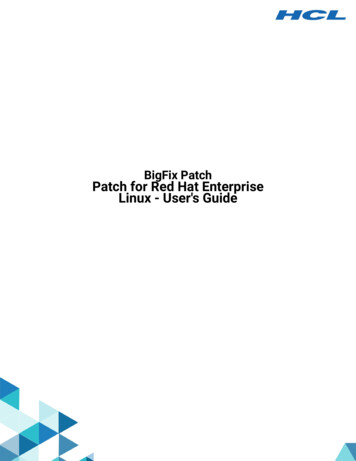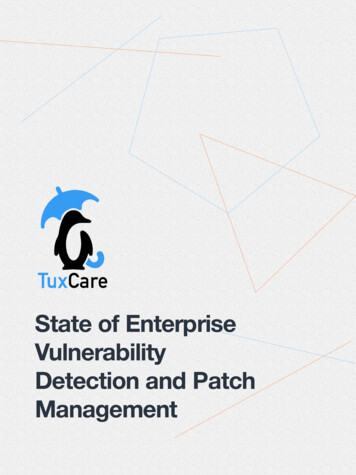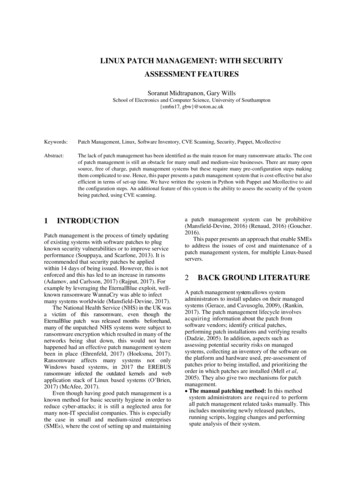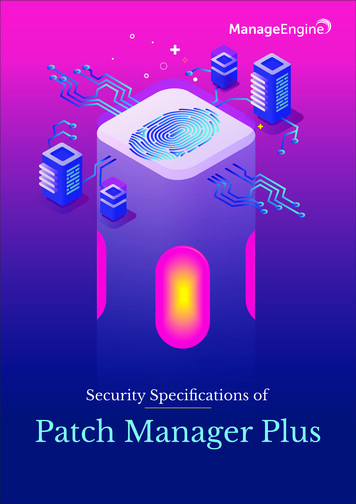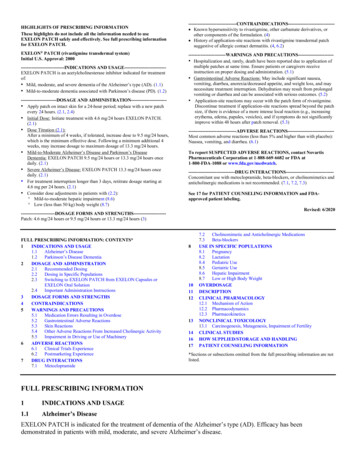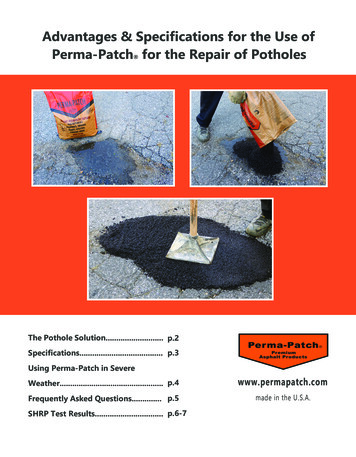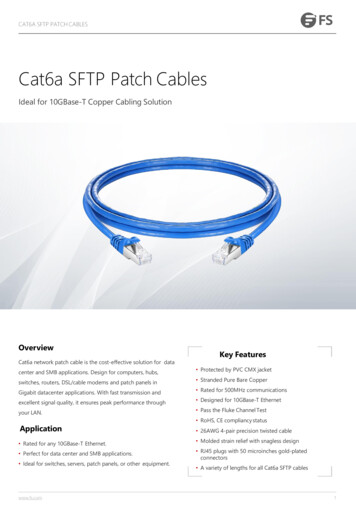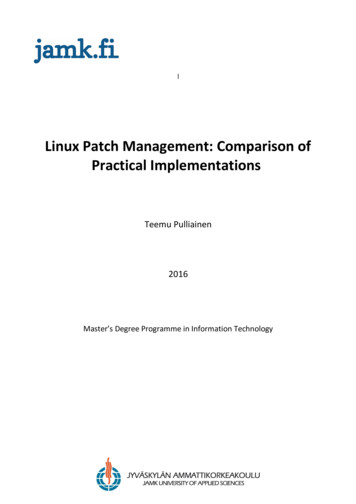
Transcription
lLinux Patch Management: Comparison ofPractical ImplementationsTeemu Pulliainen2016Master’s Degree Programme in Information Technology
AuthorPulliainen, TeemuType of publicationDateMaster’s thesisMay 2016Language of publication:EnglishNumber of pages: 71Permission for web publication: xTitle of publicationLinux Patch Management: Comparison of Practical ImplementationsDegree programmeMaster’s Degree Programme in Information TechnologySupervisorsRantonen, MikaHäkkinen, AnttiAssigned byMaatalouden Laskentakeskus OyAbstractRecent public, high-profile vulnerabilities in widely used IT architecture components pose a significant risk to IT systems. As far as public vulnerabilities are concerned, In most cases a mitigation is readily available in a form of a software patch. The remaining issues are thus how to getinformed about released patches, how to deploy them in a timely manner and how to ensurethe patches are applied to all affected targets. The answer is usually some form of a patch management system.Within a heterogeneous Linux Linux environment no established, industry standard way of deploying a patch management system exists. The objective was to study different deploymentmethods and select the most appropriate one according to the employer requirements, but alsoto give an insight on the others for the general public. An example implementation of three different patch management approaches was carried out in a test environment and each one researched and compared to the others. The first approach was creating a system from scratch thesecond using general-purpose configuration management software and the last was using a dedicated patch management software.The research was successful. A functional implementation was accomplished with each approach and valuable experience was gained on each one. The positive and negative aspects of allalternatives were examined and recommendation for the overall best solution based on the employer requirements was also given. One should note, however, that such a recommendation isheavily dependent on the environment. The actual implementation to employer environmentwas not covered.KeywordsPatch management, Configuration management, Linux
TekijäPulliainen, TeemuJulkaisun lajiOpinnäytetyö, ylempi AMKSivumääräPäivämäärä05 2015Julkaisun kielienglantiVerkkojulkaisulupamyönnetty: xTyön nimiLinux Patch Management: Comparing by Practical ImplementationsTutkinto-ohjelmaMaster’s Degree Programme in Information TechnologyTyön ohjaajatRantonen, MikaHäkkinen, AnttiToimeksiantajaMaatalouden Laskentakeskus OyTiivistelmäViimeaikaiset laajaa julkisuutta saaneet haavoittuvuudet kriittisissä tietoteknisten järjestelmien komponenteissa aiheuttavat merkittävän riskin tietojärjestelmien toiminnalle.Yleiseen tietoon tulevien haavoittuvuuksien osalta korjauspäivitykset ovat useimmitensaatavilla. Jäljelle jäävät kysymykset koskevat siis sitä, kuinka saada tieto päivitystenjulkaisemisesta, kuinka päivitykset asennetaan järkevässä ajassa ja kuinka varmistua päivitysten asentumisesta. Usein vastauksena toimii päivitysten hallintajärjestelmä.Useita jakeluversioita käsittävien Linux-ympäristöjen osalta ei ole olemassa vakiintunuttatapaa ottaa käyttöön järjestelmä päivitysten hallintaa varten. Tavoitteena oli tutkia erilaisiatapoja hallintajärjestelmän käyttöönottoon ja valita niistä toimeksiantajan kriteereihinparhaiten sopiva toteutus. Toisena tavoitteena oli tarjota suurelle yleisölle tietoa eritavoista päivitysten hallintaan Linux-ympäristöissä. Kolme erilaista esimerkkitoteutustaotettiin käyttöön testiympäristössä. Eri toteutustapoja tutkittiin ja verrattiin muihin. Ensimmäisenä toteutustapana toimi täysin itse kehitetty järjestelmä, toisena yleisten asetustenhallintatyökalujen käyttöön perustuva järjestelmä ja kolmantena nimenomaan päivitystenhallintaan tarkoitettu järjestelmä.Tutkimus onnistui ja jokaisella tutkitulla toteutusvaihtoehdolla saatiin otettua käyttöönmekanismi päivitysten hallintaan. Vaihtoehdoista saatiin kerättyä hyödyllistä tietoa, niidenhyviä ja huonoja puolia punnittiin ja toimeksiantajan vaatimusten perusteella saatiin aikaansuositus toteutettavasta järjestelmästä. Myös yleistä tietoa ja suosituksia eri järjestelmiensoveltuvuudesta erilaisiin ympäristöihin saatiin tuotettua.Avainsanat (asiasanat)Linux, muutoksenhallinta, konfiguraation hallinta, tietoturvapäivitys
1Contents1 Introduction.41.1 Assigner.41.2 Motivation and Background.41.3 Thesis Execution Phases.51.4 Objectives and Methods of the Research.51.5 Research Scope, Delimitation and Known Challenges.72 Background to the Research.82.1 Vulnerabilities and Attack Vectors.92.2 Theory and Processes of Patch Management.102.3 Architecture of Patch Management Software.162.4 Introduction to Linux Software Management.213 Test Environment.223.1 Overview.223.2 Internal Software Repository.224 Implementation Options.244.1 n.24Testing Patch Automation on Command Line.25Patch automation on CLI: an interactive approach.26Creating a Proof-of-Concept Web Interface.29Creating the Patching Application.314.2 Automatizing with Configuration Management Software.394.2.1 Introducing Configuration Management Systems.394.2.2 Deploying Ansible.414.3 Patch Management Software.504.3.1 Introduction to Spacewalk.504.3.2 Installing and Configuring Spacewalk.504.4 Comparison.575 Conclusions.595.1 Self-Created PatchApp.59
25.2 Configuration Management Approach.615.3 Spacewalk.625.4 Final Conclusions.635.5 Reflections on the Research and Further Study.64References.66Appendices.68FiguresFigure 1. Architecture proposal (Nicastro, 2011, Chapter 3).12Figure 2. Architecture proposal from White (2004, 2).19Figure. 3. Test network topology.23Figure 4. Running apt-get on Debian cluster.28Figure 5. Running uname on all clusters.28Figure 6. Initial PSSH output on browser.31Figure 7. Front page with host listing.36Figure 8. Confirmation dialog before update.37Figure 9. Deploying updates.38Figure 10. Semaphore hosts definition.48Figure 11. Ansible jobs.49Figure 12. Tasks view in semaphore.49Figure 13. Centos host added to Spacewalk.52Figure 14. Populating Spacewalk repository manually.54Figure 15. Spacewalk hosts view.55Figure 16. Spacewalk upgrade view.56TablesTable 1. Debian repository/channel relations.53Table 2. Verbal review.58Table 3. Calculating the final scores.59
AMLyumAdvanced Package ToolCommand LineCascading Style SheetsCommunity enterprise Operating SystemDomain Name SystemDenial of ServiceExtra Packages for Enterprise LinuxExtra Packages for Enterprise LinuxElastic Sky X integratedGraphical User InterfaceHypertext Markup LanguageHypertext Transfer Protocol SecureIntrusion Detection SystemsInternet ProtocolIT Infrastructure LibraryMedia Control AddressMaatalouden Laskentakeskus OyNetwork Access ControlNational Institute of Standards and TechnologyOpen Source Vulnerability DatabasePHP Hypertext PreprocessorPip Installs PythonPublic Key Infrastructureparallel-sshRivest, Shamir, AdlemanSecure SHellSecure Sockets Layer/Transport Layer SecurityStandard errorStandard outputswitch user doTeletypeUser InterfaceUniform Resource LocatorVirtual Private NetworkeXtensible Markup Language – Remote Procedure CallYAML Ain't Markup Languageyellowdog updater modified
41Introduction1.1 AssignerThe thesis assigner Maatalouden Laskentakeskus Oy (MLOY, Agricultural Data Processing Centre Ltd.) is a leading software and IT solutions provider in the Finnish agricultural sector. Located in Vantaa, MLOY employs approximately 110 people and hasa revenue of over EUR 9 million as of 2014. MLOY as a company was founded in 1986but has history of over 60 years and now possesses a rare combination of both technological and agricultural competence. (Maatalouden Laskentakeskus Oy, 2014, 2-3).1.2 Motivation and BackgroundThe assigner already had a patch management policy and certain systems and guidelines in place to carry out the policy. Separate development, test and production environments did exist as well. However, the process was very Windows-centric and theprocess only partially covered the growing number of Linux hosts. Linux hosts inMLOY were updated manually, one by one as needed. The hosts were updated directly from their distribution repository servers over the Internet. The hosts mightnot be on the same patch levels and there was no clear picture what the currentoverall Linux patch situation was.The primary motivator for the research was the requirement for a more streamlinedand formal Linux patch management process by both the assigner and other technical personnel. The recent vulnerabilities with large scale and high visibility (Chapter 2)motivated the research even further. It was decided that the patching process should
5ideally be technically trivial to follow and give the company an insight on the currentpatch situation.1.3 Thesis Execution PhasesA set of requirements the resulting system should fulfill were assessed based on bothcompany requirements introduced later and industry best practices described in thesecond chapter. The following three different approaches to implementing a patchmanagement system were experimented with:1. a self-created automatizing solution2. implementation with existing automatizing tools and3. dedicated patch management software.A test environment was built and an implementation of each patch management system approach was carried out in the test environment. The capabilities of the implemented solutions options were evaluated based on the aforementioned requirements as well as existing deployments and literature. The different solutions werethen compared with each other. Based on the requirements, the most suitable solution for the MLOY environment was selected for implementation in the productionenvironment.1.4 Objectives and Methods of the ResearchThe primary goal of this thesis was to review and compare different methods of implementing a patch management system. The review and comparison was done in or-
6der to provide the assigning organization with a solid base for choosing and implementing such a system. Based on the author's familiarity with the environments aswell as opinions by colleagues, the system was to ideally meet at least most of thefollowing requirements for its features:1. Comprehensive: include most of the Linux hosts within the organization, bothDebian (6, “Squeeze”; 7, “Wheezy”; 8, “Jessie”) and Red Hat (6 and 7) -basedones.2. Easy to use: usable for systems administrators with little Linux know-how, forexample by utilizing a web front-end.3. Controllable: include a mechanism to select which patches to apply and towhich hosts.4. Report-friendly: include a mechanism to show which patches have been applied, which are missing and a graphical summary.Another objective was to provide the general public with an overview of differentpatch management solutions for a small-scale, but possibly complex and heterogeneous Linux infrastructure. The solution was to, however, ideally scale to more complex environments as well.The primary research problem can be described as “How to select the best patchmanagement system”. Due to the broad scope and the relative vagueness of the research problem, case study was selected as the research method. A case study is a“method used to narrow down a very broad field of research into one easily researchable topic” (Shuttleworth, 2008, 1). A case study also does not attempt to findan ultimate truth based on bare numeric data. Instead, the focus of a case study is toseek a holistic understanding of the situation and to provide “new variables andquestions for further research” (Becker, 2012). The thesis includes mostly qualitative
7elements (verbal capability assessment) but there are to be some quantitative ones(calculated, score-based capability assessment) as well. A hypothesis of the capabilities of each solution was made based on literature. A real-life experiment with thesolution was then conducted to observe how it compared to the results achieved inreal life.1.5 Research Scope, Delimitation and Known ChallengesThe thesis is supposed to give an overview of different patch management methodsand offer a closer look on a few solutions. Based on time and environmental restrictions, the following delimitations were made: Since the size of the assigner's Linux infrastructure is limited, the focus will beon a relatively small-scale deployment. The solution is supposed to cover multiple operating systems, versions and architectures: however, based on the existing assigner architecture, only Debian6, Debian 7 and Red Hat 6 -based operating systems on Intel x86 and x86-64architectures are covered in the test implementation phase. The focus will be on systems operating on server roles, little thought will begiven to desktop-related questions. Since configuration management is a wide topic of its own and there are numerous quite complex solutions to implement it, the configuration management focus will be on literature review, although one configuration management tool will be investigated in more detail. The thesis focuses primarily on patching the operating system: the kernel,userspace tools (bash etc.) and frameworks/middleware (Tomcat, PHP, MySQLetc.). Application patching will be given little attention.
8 Different types of patches exist: they may provide functionality updates ornew features as well as security updates (Nicastro, 2011, Chapter 1). The focus in this thesis is on security-related matters.While automating a patch management process can yield substantial benefits, quite afew challenges were recognized already before the implementation phase. The question whether to address the following issues was postponed to the implementationphase: Change management: how to stay aware of installed software. How to get notified about available updates. How to keep track of patch levels between hosts and be certain a specificpatch has been applied to all hosts required.2 Background to the ResearchThe constant growth of threats against information systems in recent years has leadto a growing need to address public security vulnerabilities throughout the organization without delay. While it is indeed possible to update – or patch – each computersystem individually, it is becoming more and more evident that a centralized updatingsystem would be a more reliable, simpler and less time consuming option. Many organizations have already deployed a patch management system for their Windows infrastructure. Recent threats in Linux environments at the least – such as the OpenSSLvulnerability Heartbleed (Codenomicon, 2014), Bash shell vulnerability Shellshock(NVD, 2014) and C-library vulnerability Ghost (Sarwate, 2015) - have shown thatthere is also a growing demand for similar systems for Linux environments.
92.1 Vulnerabilities and Attack VectorsThe Heartbleed vulnerability, for instance, is a serious vulnerability in the ubiquitousOpenSSL cryptographic library which often provides cryptographic functions for web,email, VPN (Virtual Private Network) and instant messaging services. When disclosedin April 2014 it ended up in news headlines and created a strong pressure for thetechnical staff to address the issue without delay (Aro, 2014). What made the Heartbleed vulnerability particularly notorious was the fact that by exploiting it, private information – such as private cryptographic keys – could potentially be disclosed without leaving a trace. This led to a massive number of SSL/TLS (Secure SocketsLayer/Transport Layer Security) certificates being revoked and reissued. Another particularly nasty feature of the Heartbleed bug was that it resided in many devices thatwere not updated regularly if ever. (Codenomicon, 2014). Possible attack vectors forthe Heartbleed vulnerability include a public Apache web server over HTTPS (Hypertext Transfer Protocol Secure) using vulnerable OpenSSL libraries.The GHOST vulnerability – named after the vulnerable gethostbyname() function – isa serious vulnerability in the glibc library. Glibc is an implementation of the standardC library often used as a core component in Linux environments. GHOST is a bufferoverflow vulnerability in a glibc function providing name resolution that can be triggered remotely and could lead to a total system compromise. Example exploitsagainst the Exim email server were quickly published after the vulnerability was disclosed in January 2015, followed by a ready-to-use Metasploit module. Potentially,any software component that can be deceived to make a DNS (Domain Name System)resolution query by utilizing the gethostbyname() function in a vulnerable glibc installation could be used as an attack vector. Like Heartbleed, the vulnerability was extremely widespread due to the popularity of the glibc library. (Sarwate, 2015).
10Another example is a vulnerability in the ImageMagick image manipulating library, labeled ImageTragick. The ImageTragick bug could allow remote code execution for instance on a web forum software. Remote code execution could be triggered if a useris able to upload a malicious image which is then processed by the vulnerable software component. An example of the above is a public WordPress site which allowspublic image upload and uses ImageMagick software or the PHP (PHP Hypertext Preprocessor) extension php-imagick for image manipulation. When disclosed on May 4 th2016, only a workaround existed, as well as partial fix on the ImageMagick sourcecode. Binary packages offered by numerous operating systems were still vulnerablewith updates expected on the coming days. (Ermishkin, 2016).On the previous examples a patch management system – along with a patch management process – would greatly improve the patch coverage (which platforms are already patched). A patch management system could also help in determining when apatch is published and how severe the addressed vulnerability is. As Nicastro (2011,Chapter 1) puts it, ”A comprehensive security patch management process is a fundamental security requirement for any organization that uses computers, networks, orapplications for doing business today.”2.2 Theory and Processes of Patch ManagementSoyppaua (2013, 2) defines patch managements as “the process for identifying, acquiring, installing, and verifying patches for products and systems”. Patch management is often considered a subset of configuration management and closely relatedto risk management as well. When implementing a systematic patch managementapproach, it is usually required to analyze the threat and the vulnerability that thepatch applies to in order to be able to calculate the risk of not patching. (Voldal,2003, 1-2).
11Usually multiple, perhaps overlapping, mechanisms for applying patches exist. Suchmechanisms could include the following (Soyppaua, 2013, 4): Self-updating software Operating-system level centralized update tool [such as yum (yellowdog updater modified)] Third-party management application (such as Spacewalk) Network Access Control (NAC) software User-initiated installation or upgrade.Developing or implementing a patch management system should most likely begin byimplementing a patch management process (Nicastro, Chapter 3). The process itselfoften defined as a flow consisting of different key stages. Nicastro (Chapter 4) suggests utilizing ITIL (IT Infrastructure Library) to creating such a process.
12In Nicastro's approach, a patch management process consists of the seven stages illustrated below in Figure 1:Figure 1. Architecture proposal (Nicastro, 2011, Chapter 3)White (2004, 3-5) takes quite a similar approach defining his patch managementprocess in the following seven stages:Information GatheringWhite further divides the first stage, information gathering, into two sub-stages, asset and host management and vulnerability notification. Asset and host managementphase includes identifying which hosts and what kind of software is running on thenetwork. White suggests a continuous process of identifying these elements and apassive method where no agent software is required. Collected information shouldinclude IP (Internet Protocol) and MAC (Media Control Address) addresses and software version information as well as server functions and running services. In order tobe able to determine whether a patch should be installed immediately or not, systems should then be classified according to levels of importance. White suggeststhree levels: mission critical (highest, critical to business operation), business critical
13and operational critical (lowest, can tolerate service breaks). Similarily, Nicastro(Chapter 3) finds an accurate inventory of systems essential in order to implementdifferent patching strategies for different kinds of systems: desktops, servers and network appliances.In White's work (2004, 4), vulnerability notification sub-stage relates to gathering information about found vulnerabilities and released patches. The information shouldinclude affected software versions, seriousness rating and possible temporary workarounds. White suggests subscribing to relevant security announcement lists andpublic disclosure lists to achieve this information.In a similar fashion, Nicastro (2011, Chapter 2) suggests one of two approaches totracking new patch releases: either crawling through known-good web page sourcesand subscribing to relevant mailing lists, or using a third-party service or softwaretool. If using the first option, Nicastro lists a few information sources such as UnitedStates Computer Emergency Readiness Team (US-CERT) ”Technical Cyber SecurityAlerts” and ”@Risk: The Consensus Security Alert” by SANS Institute. When using thelatter option, Nicastro suggests handing over the systems inventory to this third partyin order to receive more relevant information. In chapter 5, Nicastro points out thatin addition to external vulnerability sources, internal ones should be used as well.These include information gathered from network devices, IDSs (Intrusion DetectionSystems), firewalls and so on as a part of routine security operations. This information could help in finding vulnerabilities as well as assessing the threat to the particular systems.SchedulingWhite (2004, 4) proposes scheduling patches in two different cycles. First, thereshould be a normal cycle to install non-critical patches e.g. monthly or whenever service packs are released. In addition, critical patches should be installed wheneverthey are announced. Patch priority should be calculated based on criticality an-
14nounced by the vendor, availability of exploit, importance and exposure of the affected systems and exposure of the affected systems. Nicastro (2011, Chapter 9) alsosuggests using static time frames for patch installation based on the severity of thevulnerability. In Nicastro's example a time frame for emergency-level patches couldbe within twelve hours whereas information-level patches might be left uninstalledaltogether.TestingTesting should be considered critical to the patch management process and should bedone in an exact mirror of the production environment whenever possible. If this isnot possible, the patches should first be rolled out to easily-recoverable systems.(White, 2004, 4-5). Nicastro (2011, chapter 8) recognizes the same issues and alsorecommends using a patch rating system to be able to concentrate on the patchesthat have the biggest effect on the organization. A virtualized test environment couldbe created as well as recommended by both White (2004, 4-5) and Nicastro (2011,Chapter 8).Change ManagementChange management stage includes planning for patch implementation. White (2004,5) suggests contingency and back-out plans should first exist. Documentation aboutwhat is installed and how to remove it should exist, as well as backups and standbypersonnel in case of failure. Risk mitigation should be considered as well so that possible complications are limited. Plans should exist for defining what criteria must bemet for the patch to be considered successful.InstallationWhite (2004, 5) calls for a well controlled and predictable installation to limit disruption to business services. Access controls should be implemented to disallow out-of-
15band patch installation by uses or automated processes. Guidelines should be writtenand checked regularly. Mission critical systems should be patched manually, duringoff-hours. Just as White, Nicastro (2011, Chapter 8) mentions the need for a well-controlled implementation by the operations group as well. Nicastro pays special attention to using pre-generated step-by-step instructions in the implementation phase.Audit and AssessmentSuccessful patch deployment should be verified by using e.g. agent software or vulnerability scanner. Reports should also be generated at this stage as well as documentation about any occurred issues. The reports should be forwarded to upper management so that they know the process is functioning as expected. In Nicastro's approach (2011, Chapter 9) a named security group generates reports and maintainsthem in a central repository or database. The documentation should include an overview of the vulnerability, test plan and results, implementation and back-out plans forall systems as well as progress reports and scorecards to track patched systems.Consistency and ComplianceWhite (2004, 5) explains this stage as a kind of a feedback where the lessons learnedare used to improve the process. An audit trail is also provided in this stage. The realworld product of this stage could be an update of images, build scripts an
second chapter. The following three different approaches to implementing a patch management system were experimented with: 1. a self-created automatizing solution 2. implementation with existing automatizing tools and 3. dedicated patch management software. A test environment was built and an implementation of each patch management sys-


